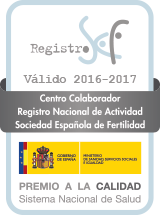Artificial insemination with donor’s sperm (AID)
Technique
Artificial insemination with donor’s sperm (AID) is a technique which consists in depositing the donor’s sperm (previously selected) to the inside of the patient’s uterus.
Initially, the patient must undergo hormone treatment (although it may also be done in natural cycles) in order to achieve growth and follicular maturation (maturation of the egg).
This treatment can last between 10 and 14 days and it is simple and slightly aggressive, since the dosages of medication given tend to be low.
Once oocyte maturation has been achieved (proved by periodic ultrasound controls performed during the treatment), ovulation is provoked within the next 36 hours and the donor sperm sample is then prepared.
Regarding donor selection, it is a complex and careful procedure which consists in carrying out a series of interviews and tests to candidates in order to rule out those with diseases of genetic or serological origin, physical examinations to verify that the reproductive organs are working well, as well as phsychological tests to assess the intelligence quotient and the integrity of the donor.
Donors tend to be young men between the ages of 18 and 30, who donate altruistically and voluntarilly sperm samples to the centre during a six-month period.
These samples are treated and frozen in order to keep them until the moment when a couple with similar physical characteristics to the those of the donor require them.
The sample preparation consists in washing it in order to remove any seminal plasma and non-motile or morphologically altered sperm. In this way, there is only good motile sperm, capable of fertilizing the egg.
Once the sample is thawed and prepared, it is placed into an insemination cannula and is left inside the patient’s uterus. The procedure is simple, quick and little painful.
Once finished, the patient will remain lying down for some minutes.
Insemination is a technique which does require neither rest nor change of life habits of the patient.
After treatment, within fifteen days, the patient will take a pregnancy test to know if pregnancy has been achieved.
Indications
1) Male sterility:
– Alterations in the sample quality
– Severe Oligoastenoteratozoospermia
– Total absence of sperm: Azoospermia
– Genetic alterations


